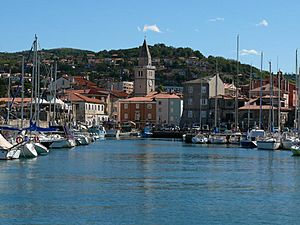Italian irredentism in Istria facts for kids
Italian irredentism in Istria was a political idea. It was about uniting the region of Istria with Italy. This movement was important for many people in Istria who felt they were Italian.
Contents
What Was Italian Irredentism in Istria?
When a famous French leader named Napoleon won against Venice in 1797, he saw something interesting in Istria. The people living along the coast and in the main cities were mostly Italians. But the people in the inner parts of Istria were mainly Croats and Slovenians.
This mix of different groups in the same area caused problems. It led to a lot of disagreement and even hostility between the Slavs (Croats and Slovenians) and the Italians. Both groups wanted to be the main power in Istria. This struggle started after Napoleon's time.
From 1815, Istria became part of the Austrian Empire. The Croats, Slovenians, and Italians continued their nationalistic fight. This means each group strongly believed their own nation and culture should be in charge.
Because of this, Istria became a place of ethnic struggle. This led to serious conflicts and wars during the 1800s and 1900s. Many Istrian Italians strongly supported Italian irredentism. One famous Italian hero from Istria was Nazario Sauro, who was from Capodistria (now called Koper).
Between 1918 and 1947, Istria was actually part of the Kingdom of Italy. But after World War II, it became part of Yugoslavia. Today, the number of Istrian Italians is much smaller. Many left their homes during the Istrian-Dalmatian exodus and faced difficult times like the Foibe massacres during and after World War II.
After World War II, a special area called the Free Territory of Trieste was created in northern Istria. Later, this area was divided between Italy and Yugoslavia. Many Istrian Italians, up to 40,000, chose to leave the Yugoslav side and move to Italy. They did this for different reasons. Some felt pressured to leave, while others simply preferred not to live in Tito's Yugoslavia.
Since the end of World War II, the idea of irredentism has almost completely disappeared in Istria. This is partly because so many Istrian Italians left. Today, Istria is mostly populated by Slavs. However, about 50,000 Italians still live there. They are spread across the parts of Istria that belong to Croatia, Slovenia, and Italy.
Important Cities: Capodistria and Muggia
The cities of Capodistria (now Koper) and Muggia were very important centers for the irredentist movement in Istria. These cities had the main Comitato istriano, which means the Istrian Committee for Union to Italy. This was where important Istrian irredentists like Carlo Combi and Antonio Madonizza met.
In 1848, many Istrian Italians sailed from these cities to fight for Venice against the Austrians. They were part of a group called the Legione Istriano-dalmata.
After 1866, when Venice and the Veneto region became part of Italy, support for irredentism grew even stronger across all of Istria. The Italian hero Nazario Sauro, mentioned earlier, was born in Capodistria.
Today, only Muggia remains part of Italy, as it is part of the Province of Trieste.
Related pages
- Istrian Italians
- Italian irredentism
- Italian irredentism in Dalmatia
Images for kids
-
Like those of Istria, most of the inhabitants of Fiume cheered the union to Italy after WWI
See also
 In Spanish: Irredentismo italiano en Istria para niños
In Spanish: Irredentismo italiano en Istria para niños



